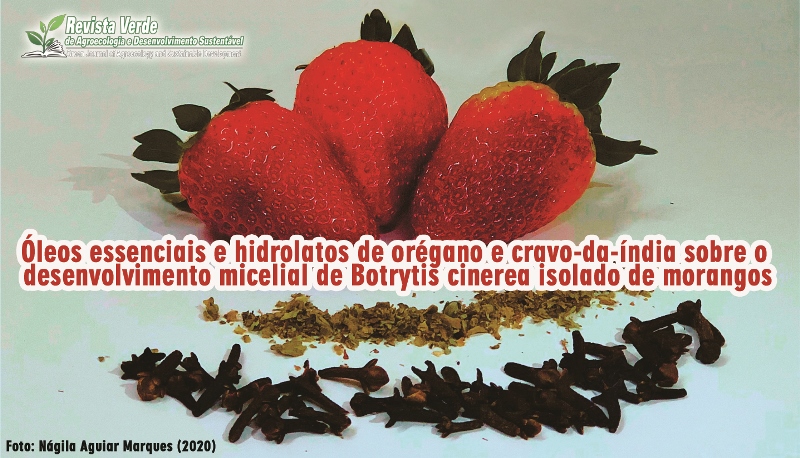Essential oils and hydrolats of oregano and clove on the mycelial development of Botrytis cinerea isolated from strawberries
DOI:
https://doi.org/10.18378/rvads.v15i4.7952Keywords:
Gray mold, Sustainable management, Natural fungicidesAbstract
The aim of this work was evaluated essential oils and hydrolats of O. vulgare and S. aromaticum, extracted by hydrodistillation, from its abilities to control mycelial growth of the fungus B. cinerea (gray mold) isolated from Albion strawberries as alternative management, ecological and sustainable to combat the disease. The inhibition of mycelial growth was evaluated in the treatments: 5, 15 e 30% for each hydrolats and 10% for each essential oil. There was no considerable fungal activity in the first 24 hours of experiment. The hydrolates are active in 48 hours at the lowest concentration (5%) with mycelial growth inhibition percent (GIP)= 94% (O. vulgare) and 84% (S. aromaticum). Hydrolats at 15% maintained the MGIP above 90% for up to 72 hours not differing statistically from 48 hours of monitoring. Hydrolats 30% treatments, the GIP was 100% all period and did not differentiate statistically between treatment days. Both essential oils differed statistically from the control after 48 until 96 hours. The O. vulgare oil was more efficient with GIP =100% for the entire experiment and the S. aromaticum oil, in 48 hours, a GIP =64% that remained until 96 hours. The study demonstrated the antifungal action against B. cinerea of all-natural extracted product tested, aqueous and oily.
Downloads
References
ANTUNES, L. E. C.; CARVALHO, G. L.; SANTOS, A. M. d. A cultura do morango. Revista e Ampliada, Embrapa Informação Tecnológica p. 9-29, 2011.
ANVISA, A. N. D. V. S. Programa de análise de resíduos de agrotóxicos em alimentos. 2016. Disponível em: <http://portal.anvisa.gov.br/noticias?p_p_id=101_INSTANCE_FXrpx9qY7FbU&programa-de-analise-de-residuos-de-agrotoxicos-em-alimentos>. Acesso em: 10 fev. 2020.
BAKKALI, F.; AVERBECK, S.; AVERBECK, D.; IDAOMAR, M. Biological effects of essential oils–a review. Food and chemical toxicology, 46, n. 2, p. 446-475, 2008. 10.1016/j.fct.2007.09.106.
BOUCHRA, C.; ACHOURI, M.; HASSANI, L. M. I.; HIMAMOUCHI, M. Chemical composition and antifungal activity of essential oils of seven Moroccan Labiatae against Botrytis cinerea Pers: Fr. Journal of ethnopharmacology, v. 89, n. 1, p. 165-169, 2003. 10.1016/S0378-8741(03)00275-7.
CASSINELLI, A. B.; LUÍS, F.; FRONZA, J.; SCHWANBACH, J. Atividade antifúngica in vitro dos óleos essenciais Eugenia uniflora e Psidium cattleianum contra o fitopatógeno Thielaviopsis basicola. Revista Eletrônica Científica da UERGS, 5, n. 3, p. 250-256, 2019. 10.21674/2448-0479.53.250-256.
DA ROCHA, C. H.; AGOSTINETTO, L.; BOFF, P.; WERNER, S. S.; SOLDI, C.; BOFF, M. I. C. Óleo essencial de Psidium cattleyanum no controle de fitopatógenos em sementes de feijão. Revista Verde de Agroecologia e Desenvolvimento Sustentável, 15, n. 1, p. 14-19, 2020. 10.18378/rvads.v15i1.7365.
FILIPPI, D. Ação antifúngica do estrato de Physalis peruviana Linnaeus frente ao fungo Botrytis cinerea. 2018. 86 f. Dissertação (Mestrado em Ciência e Tecnologia de Alimentos) -, Universidade de Passo Fundo, Passo Fundo - RS.
FONTELES, M.; GADELHA, M.; SOUZA, N.; ALENCAR, V.; MATOS, F. Algumas propriedades farmacológicas de hidrolatos de plantas do nordeste brasileiro. Acta Amazonica, 18, p. 123-127, 1988. 10.1590/1809-43921988185127.
GHINI, R. J. E. M. A.-A. e. p. i. Ocorrência de resistência a fungicidas em linhagens de Botrytis cinerea, no estado de São Paulo. 1996.
ISAZA, L.; ZULUAGA, Y. P.; MARULANDA, M. L. Morphological, pathogenic and genetic diversity of Botrytis cinerea Pers. in blackberry cultivations in Colombia. Revista Brasileira de Fruticultura 41, n. 6, 2019. 10.1590/0100-29452019490.
KIMATI, H.; AMORIM, L.; BERGAMIN FILHO, A.; CAMARGO, L.; RESENDE, J. Manual de Fitopatologia. Doenças de Plantas Cultivadas, 2, 1997.
KNAAK, N.; FIUZA, L. M. Potential of essential plant oils to control insects and microorganisms. Neotropical Biology and Conservation, 5, n. 2, p. 120-132, 2010. 10.4013/nbc.2010.52.08.
LORENZETTI, E.; MONTEIRO, F.; SOUZA, P.; SOUZA, R.; SCALICE, H.; DIOGO JR, R.; PIRES, M. Bioatividade de óleos essenciais no controle de Botrytis cinerea isolado de morangueiro. Revista Brasileira de Plantas Medicinais, 13, n. SPE, p. 619-627, 2011. 10.1590/S1516-05722011000500019.
MOURA, G. S.; JASKI, J. M.; FRANZENER, G. Potencial de extratos etanólicos de propólis e extratos aquosos de plantas espontâneas no controle de doenças pós-colheita do morango. Revista Verde, 11, n. 5, p. 57-63, 2016. 10.18378/rvads.v11i5.4175.
NASCIMENTO, D. M.; DA COSTA VIEIRA, G. H.; KRONKA, A. Z. Inibição do crescimento micelial de Fusarium solani f. sp. glycines com o uso de óleos essenciais. Journal of Neotropical Agriculture, 3, n. 4, p. 65-68, 2016. 10.32404/rean.v3i4.1195.
PASSAGLIA, V. Óleos essenciais no controle de Rhizopus stolonifer e Botrytis cinerea em morangos. 2017. 49 f. Dissertação (Mestrado em Agronomia/Fitopatologia), Universidade Federal de Lavras, Lavras.
PEIXINHO, G. S.; RIBEIRO, V. G.; AMORIM, E. P. R.; MORAIS, A. C. M. Ação do óleo essencial de Citronela (Cymbopogon nardus L) sobre o patógeno Lasiodiplodia theobromae em cachos de videira cv. Itália. Summa Phytopathologica, 45, n. 4, p. 428-431, 2019. 10.1590/0100-5405/206511.
SANTOS, M. C.; DE OLIVEIRA JUNIOR, L. F. G.; OLIVEIRA, L. F. M.; CARVALHO, C. R. D.; GAGLIARDI, P. R. Perfil volátil e potencial fungitóxico do hidrolato e extrato de sementes e folhas de Schinus terebinthifolius Raddi. Revista Ciência Agronômica, 45, n. 2, p. 284-289, 2014. 10.1590/S1806-66902014000200008.
STOCKTON AGRIMOR, D. B. L. Timorex Gold - Bula. 2018. Disponível em: <https://www.timorexgold.com.br/dev/downloads/bula-timorex/>. Acesso em: 20 Fev. 2020.











